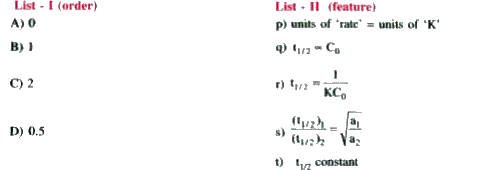In the following reaction, how is the rate of appearance of the underline product related to the rate of disappearance of the underlined reactant?
BrO−3(aq)+5Br−–––––––(aq)+6H+(aq)→3Br2––––––(1)+3H2O(1) Solution in Telugu
d[Br2]dt==53d[Br−]dt
d[Br2]dt=−d[Br−]dt
d[Br2]dt=−d[Br−]dt
d[Br2]dt=−35d[Br−]dt
The correct Answer is:D
−d[BrO−3]dt×11=−d[Br−]dt×15=d[Br2]dt×13
Topper's Solved these Questions
- CHEMICAL KINETICSBook:AAKASH SERIESChapter:CHEMICAL KINETICSExercise:LEVEL-II(LECTURE SHEET EXERCISE-II LINKED COMPREHENSION TYPE QUESTIONS)
Explore 9 Videos
- CHEMICAL KINETICSBook:AAKASH SERIESChapter:CHEMICAL KINETICSExercise:LEVEL-II(LECTURE SHEET EXERCISE-III MATCH THE FOLLOWING QUESTIONS)
Explore 3 Videos
- CHEMICAL KINETICSBook:AAKASH SERIESChapter:CHEMICAL KINETICSExercise:LEVEL-1 (EXERCISE -II ORDER, MOLECULARITY, HALF LIFE:)
Explore 34 Videos
- CHEMICAL KINETCSBook:AAKASH SERIESChapter:CHEMICAL KINETCSExercise:EXERCISE - 3.2
Explore 45 Videos
- CHEMICAL THERMODYNAMICSBook:AAKASH SERIESChapter:CHEMICAL THERMODYNAMICSExercise:Additional Practice Exercise
Explore 54 Videos
Similar Questions
A certain endothermic reaction: A→ Product, ΔH=+ve proceeds ina sequence of three elementary steps with the rate constant K1,K2 and K3 and each one having energy of activation E1,E2 and E3 respectively at 25∘C. The observed rate constannt for the reaction is equal to K3√K1K2.
A1,A2 and A3 are Arrhenius parameters respectively.
The observed energy of activation for the reaction is
View SolutionMatch the following columns

View SolutionSucrose decompose in acid solution into glucose and fructose according to the first order rate law, with t12=3.00 hours. What fraction of sample of sucrose remains after 8 hours ?
View SolutionDiscuss on the kinetic spontaneity of a chemical reaction. Is a slow reaction spontaneous? Why?
View SolutionWhich among the following is not an exact differential?
View SolutionIn the following reaction, how is the rate of appearance of the underlined Product related to the rate of disappearance of the underlined reactant ?
BrOɵ3(aq)+5Br–––ɵ(aq)+6H⊕(aq)→3Br2––––(l)+3H2O(l)
View SolutionIn the reaction BrO^(-3)(aq) + 5Br^(-) (aq) + 6H^(+) rarr 3Br_(2)(1) + 3H_(2)O(1) The rate of appearance of bromine (Br_(2)) is related to rate of disapperance of bromide ions as folllwoing :
View SolutionWhich of the following expression is correct for the rate of reaction given below ? 5Br^(-)(aq) + BrO_(3)^(-)(aq) + 6H^(+) (aq) to 3Br_(2) (aq) + 3H_(2) O(l) .
View SolutionConsider the following reaction in aqueous solution
5Br−(aq)+BrO−3(aq)+6H+(aq)→3Br2(aq)+3H2O(l)
If the rate of appearance of Br2 at a particular time during the reaction is 0.025Msec−1, what is the rate of disappearance (in Msec−1) of Br− at that time?
View Solutionअभिक्रिया BrO−3(aq)+5Br−(aq)+6H+→3Br2(l)+3H2O(l) में, ब्रोमीन (Br2) के प्रगटीकरण की दर, ब्रोमाइड आयनों के लुप्त होने की दर से निम्न प्रकार संबंधित है
View Solutionनिम्नलिखित अभिक्रिया में रेखांकित उत्पाद के निर्माण की दर रेखांकित अभिकारक की विलुप्त होने की दर से किस प्रकार संबंधित है BrO−3–––––––(aq)+5Br−1(aq)+6H+(aq)→3Br2––––––(l)+3H2O(aq)
View SolutionIn the reaction
BrO−3(aq)+5Br−+6H+→3Br2+3H2O
the rate of appearance of bromine is related to the rate of disappearance of bromide ions as :
View SolutionIn the reaction BrO_(3).^(-)(aq)+5Br^(-)(aq)+6H^(+) to 3Br_(2)(l)+3H_(2)O(l) The rate of appearance of bromine (Br_(2)) is related to rate of disappearance of bromide ions as following
View SolutionWhich of the following expression is correct for the rate of reaction given below ? 5Br^(-)(aq) + BrO_(3)^(-)(aq) + 6H^(+) (aq) to 3Br_(2) (aq) + 3H_(2) O(l) .
View SolutionIn the following reaction, how is the rate of appearance of the underlined Product related to the rate of disappearance of the underlined reactant ? BrO_(3)^(ɵ)(aq) + 5underline(Br)^(ɵ)(aq) + 6H^(o+) (aq) rarr 3underline(Br_(2))(l) + 3H_(2)O(l)
View Solution

